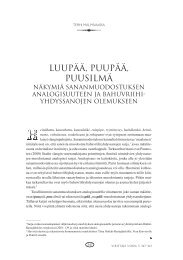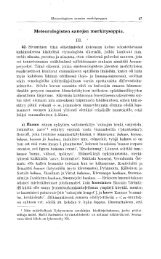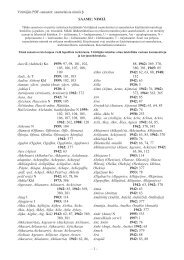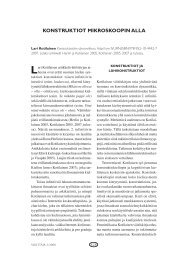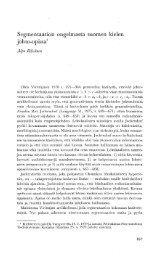pdf-tiedostona - Kotikielen Seura
pdf-tiedostona - Kotikielen Seura
pdf-tiedostona - Kotikielen Seura
Create successful ePaper yourself
Turn your PDF publications into a flip-book with our unique Google optimized e-Paper software.
TERHO ITKONEN<br />
early Proto-Finnic has paved the way<br />
for the generalization of the partitive<br />
subject at the same time and in exactly<br />
the same direction as did the partitive<br />
object of early Proto-Finnic. The construction<br />
in paljo(n) and vaha(n) particularly<br />
might have offered a firm ground<br />
for this development. It is possible that<br />
they could have been analysed already<br />
in Proto-Finnic in a manner which is a<br />
possible alternative in modern Finnish<br />
also: in sentences such as Sain paljon rahaa<br />
'I got a lot of money', Minulla on paljon<br />
rahaa T have a lot of money', paljon is<br />
no object or subject but rather an adverbial<br />
of quantity just as in the synonymous<br />
sentences Sain runsaasii rahaa<br />
'I got money terrifically', Minulla oli<br />
runsaasti rahaa 'I had money terrifically'.<br />
If so, rahaa was no longer a partitive<br />
attribute but rather a partitive object<br />
or — in the latter example — the partitive<br />
subject of an existential sentence.<br />
2.4.4. In 1.4 a phenomenon was discussed<br />
which formally distinguishes the<br />
system of the Finnish subject and object<br />
cases from a normal ergative system.The<br />
Finnish nominative has no ending, the<br />
accusative case sometimes has an ending<br />
and the partitive case always has one.<br />
In ergative systems, on the other hand,<br />
the ergative case (= that which most<br />
closely corresponds to the Finnish nominative<br />
in an ergative system) has an<br />
ending, whereas the nominative, which is<br />
its opposite (= the case corresponding<br />
to the Finnish partitive/accusative),<br />
usually has no ending. In the same<br />
connection, an attempt at synchronic explanation<br />
on the basis of the theory of<br />
markedness was presented to clarify this<br />
discrepancy. Still, this phenomenon may<br />
also be studied from the standpoint of<br />
diachrony. From this standpoint it might<br />
be instructive to discover what the sources<br />
of the case named ergative are.<br />
The original function of the ergative<br />
case has not been satisfactorily determined<br />
in all instances. Nevertheless some kind<br />
of guide is provided by those languages<br />
in which the ergative still has, in addition<br />
to its fvinction as the subject of a transitive<br />
verb, other ones which are more original,<br />
and by those languages in which the transitive<br />
subject can be expressed by some<br />
other case in addition to the monofunctional<br />
ergative. One and the same<br />
case form turns out to have in addition<br />
to its ergative function an instrumental,<br />
locative, ablative, or dative function depending<br />
on the language. Thus the<br />
original oblique cases which expressed<br />
62<br />
the means of action, its location or origin,<br />
or (as is particularly the case in several<br />
Caucasian languages in connection with<br />
verbs expressing feeling or perception) its<br />
direction of influence has been agentivized<br />
in different languages so as to assume<br />
the function of the subject. This meant<br />
that the original non-differentiated case<br />
of the subject and object was restricted<br />
to express the non-agentive unit. In<br />
practice the boundary between agentivity<br />
and non-agentivity has generally tried to<br />
be connected with the boundary between<br />
transitivity and non-transitivity. This is<br />
easy to understand: the spread of the<br />
new case of the subject preceded no<br />
further than was absolutely necessary.<br />
Transitive sentences were, after all, the<br />
only ones in which the difference between<br />
the subject and object required emphasis<br />
by the use of a different case.<br />
A corresponding line of development<br />
can be seen in those cases where the<br />
ergative function seems to have developed<br />
from a possessive function (e.g. Delaware,<br />
Eskimo-Aleutian in which the ergative<br />
still has both functions). The fact that<br />
the case indicating the possessor has<br />
developed into the subject of a transitive<br />
sentence is in principle no stranger a<br />
phenomenon than the development of<br />
verbs corresponding to habeo to auxiliaries<br />
used in the formation of periphrastic<br />
tenses of transitive verbs: French J'at<br />
lu le livre, German Ich habe das Fenster<br />
geoffnet. A further parallel is provided by<br />
the similarity observable in several<br />
languages between the affixes of the<br />
objective conjugation and possessive affixes.<br />
This holds equally true for several<br />
non-ergative Uralic languages and for<br />
such ergative languages as Abkhaz,<br />
Abaza, and Eskimo-Aleutian. This cannot<br />
be said to know of no exception; on<br />
the contrary the constructions typical of<br />
transitive sentences have in different<br />
languages demonstrated a tendency to<br />
fill in space from intransitive sentence,<br />
at least probably partially aided by such<br />
sentence types in which the intransitive<br />
subject is agentive. In the habeo constructions<br />
this is general, and in a similar<br />
manner the personal endings similar to<br />
possessive suffixes have spread in the<br />
Finno-Ugric languages partially to intransitive<br />
verbs as well.<br />
In the light of examples of this type it<br />
is possible to make the working hypothesis<br />
that the ending of the ergative case<br />
may generally be traced back to some<br />
originally marked case — the instrumental,<br />
locative, ablative, dative, or



